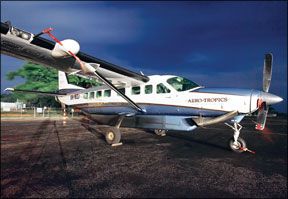Conceived as a next generation bushplane with turbine power, the Caravan was a huge risk for Cessna to take at a time when aircraft sales were collapsing and the selling price of a new turboprop would have to be multiples of the prices for the used, piston-pounding DeHavilland Beavers and Otters with which it was to compete. At $650,000 in 1985, the folks who worked airplanes hard for a living wore down a lot of sharp pencils trying to figure out whether Cessnas new load hauler would also carry the debt load that would come with it.
Fortunately, aviation’s working class soon found out that the Caravan was so reliable and hauled so much at a very reasonable speed that it turned a nice profit. The word got around and sales, especially as Federal Express bought a slew and reported amazing dispatch reliability, took off, with more than 1700 delivered to date, even as the price has crept up just past the $2 million mark.
As imitation is the most sincere form of flattery, those businesses who stuck with Beavers and Otters have been incurring their own big debt load as they convert them to turbine power in order to compete with the Caravan operators.
History of the Line
In the early 1980s, Cessnas Pawnee Division, where the 208 was designed, enjoyed a period of productive serendipity. John Berwick, a knowledgeable chief engineer with extensive experience in homebuilt aircraft, teamed with Dave Ellis, one of the finest advance design engineers in general aviation. The flight test department was headed by legendary general aviation test pilot Bruce Barrett. This team produced two of the best handling airplanes ever built, the T303 and the 208. Only the Cirrus series is as nice to fly as these airplanes.
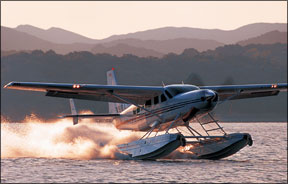
With the success of its utility line of singles, the 180, 185, 205, 206 and 207 (in seven- and eight-seat versions) and the booming aviation market of the late 1970s, Cessna felt it could develop a bigger single-engine hauler. This new airplane would carry DeHavilland Beaver- or Otter-sized loads, but at decent speeds, perhaps replacing those aging workhorses.
Cessna did its homework. Its engineers spent hours flying with the users of the 180 and 206 series on wheels and floats to find out what was good and what could be improved in a bigger machine. They visited bush operators in the Yukon and Alaska and the oil rig-supply operators in Louisiana. Many got a little dry-mouthed at the rides they had, but they came away with the understanding that working airplane operators wanted strength, toughness, absolute reliability, or at least something that could be fixed easily in the middle of nowhere.
They also wanted the ability to haul as big a load as possible, a huge cargo door so the airplane could be loaded with a fork lift, a flat floor and as few things that could break as possible. They didn’t care about creature comforts, yet were very aware of pilot fatigue and the resultant faulty decision-making that comes from hours in a poorly-designed seat in a roaring, vibrating airplane. They also wanted a tailwheel. Yet all complained of the difficulty in finding competent tailwheel pilots, in Alaska or anywhere else.
207 Template
The starting point was Cessnas limousine-with-wings, the 207, which was simply widened. That plan didn’t last long. The next step was to look at what the users wanted and what the company had a history of doing well. The result was a strut-braced, high-wing, nosewheel airplane that was extremely strong.
The tubular main landing gear appears to be one long piece, although its really a
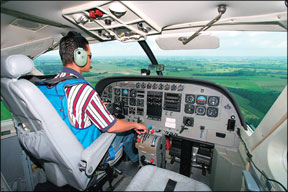
Laszlo Daniel
three-piece steel tube arrangement that’s hell for stout but is attached to the fuselage in such a way that it can be quickly removed to install floats. Also, it will snap off in a crash without deforming the cabin floor, thus helping to keep the folks inside alive.
The nosewheel was built substantially larger than anything seen before and has an oil snubber arrangement that eliminates air space that can lead to condensation and ice crystals in cold environments and also obviates oleo strut leaks. The nose strut is braced with a drag link that started life as a main landing gear leg for a 172, thus it can handle severe up and aft loads.
The only Cessnas the military bought in quantity after the Bird Dog had nosewheels and Cessna wanted to sell the 208 to the military. Cessna had also learned that airplanes that require finesse to fly, such as the Cardinal, don’t sell well, so the 208 would have to be easy to handle. Reluctantly, the tailwheel that bush operators wanted was ruled out.
Cessna was still uncertain about whether to go ahead with final development and production of the 208 until its discussions with Federal Express bore fruit. FedEx, looking for a way to service smaller communities, agreed to buy more than 100 208s right off the bat, with options for more. As it happened, FedEx got the first several hundred airplanes. Their experience evidently impressed other potential customers, for there are more than 1700 Caravans in service, fewer than half of which were originally built for Federal Express.
By the end of 1985, Cessna had certificated the 208A Cargomaster, essentially the 208 with no windows, different avionics and no air stair door. Its believed that all 208As have been modified back into the 208 “no letter” configuration.
Powerplant
The powerplant decision was difficult. A heavy hauler requires lots of power. Turbines provide that kind of power in small packages with reliability and long periods between overhaul when compared to pistons. However, they’re staggeringly expensive for an operator flying single-engine bushplanes. Still, in Cessnas favor was that it was becoming difficult to obtain avgas in many parts of the world. So the nod went to the Pratt & Whitney PT-6A-114 with 600 shaft horsepower. It would swing a wide-chord, 100-inch long, Kevlar propeller from Hartzell. The engine was canted down and to the right to minimize the effects of power changes. The PT-6A earned a reputation as a reliable, easy-to-operate workhorse and history has proven that Cessna chose right.
The fuselage was designed to carry 10 people without being too cramped and still have a cargo area behind the seats the size of a regular pickup truck bed. The 62-inch wide cabin allows three abreast seating with an aisle.
Float operators wanted doors on each side of the fuselage for docking, so two crew doors were mandated. The doors open a full 180 degrees so that a person on a float can get past the open door quickly. A 50-inch high by 49-inch wide cargo door on the left side of the fuselage is split so that the top half opens upward while the bottom swings to the side. It can be removed and a roll-up door installed for skydiving operations.
The cargo door is behind the wing so a forklift can drive up to the fuselage at a 90-degree angle. Opposite the cargo door is an air stair for the comfort of passengers. Because the floor is 42 inches off the ground, the pilots board via individual ladders that cleverly fold to form outboard arm rests for the crew seats. The seats were designed to progressively collapse or “stroke” to meet the new FARs for impact loads.
High-Performance Wing
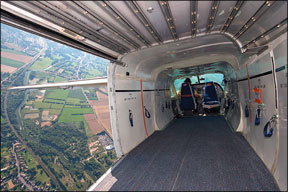
Willem Honders
To get the necessary cruise performance, a high-aspect ratio wing was chosen, with a NACA 230 series airfoil, similar to the 300 and 400 series Cessnas. It needed such long span flaps to reduce the stall speed to the required 61 knots that there was little room left for ailerons.
Even with a span of more than 51 feet, the available aileron area simply couldn’t give the roll control desired. Cessna had built a Model 308 in the early 1950s with a wing only four feet shorter and discovered just how sluggish in roll a long wing could be. In what is still a surprisingly little known decision, the Caravans roll control is primarily via “slot-lip” spoilers that start moving when the up aileron deflection goes past 5 degrees. The relatively small ailerons are considered “feeler” ailerons and mostly exist to get rid of the dead spot in a spoiler control system when both spoilers are stowed. The result is that a pilot who isn’t told about the spoilers will never guess they exist, other than noticing there’s almost no adverse yaw with roll input.
The wing structure is designed so that failure of one or two components will not be catastrophic. For crashworthiness considerations, fuel is stored between the spars and we’ll outboard of the cabin. The flaps reduce the stall speed by a full 14 knots at max extension, 30 degrees. There’s virtually no pitch change during extension or retraction.
Simple Systems
Systems were made to be as simple as possible. The flaps are electric and there’s no hydraulic system other than for the brakes. The inertial separator in the engine intake is manually controlled by what looks like a snow shovel handle. The cowling halves can be opened with three simple latches. A pilot facing a morning start after a freezing night can take the battery out of the airplane in about 30 seconds and carry it in where it can stay warm.
The engine controls for the PT-6A are standard. However, there’s an additional emergency power lever to the left of the power lever. Its connected to the manual override lever on the fuel control unit of the engine and governs fuel supply to the engine should a pneumatic malfunction occur in the fuel control unit. A pneumatic failure results in the fuel flow dropping to minimum idle power setting. The emergency power lever allows the pilot to restore power in the event of a pneumatic failure. It makes a very reliable engine even more reliable.
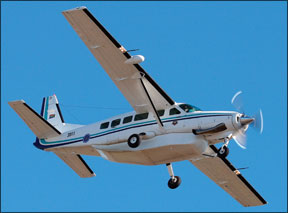
Originally, the 208 was certified with a Hartzell composite propeller to keep weight down, plus the Hartzell had fairly short, wide-chord blades, which improved ground clearance considered to be essential to avoid erosion on unimproved strips and on the water. Naturally, this made one of Cessnas divisions, McCauley, unhappy, as it had provided most of the propellers for Cessnas for years. McCauley then developed a 106-inch diameter aluminum propeller which was eventually offered as an option.
McCauleys timing proved fortuitous as field experience with the Hartzell composite was not good. Erosion, even with a metal leading edge, proved to be worse than anticipated. While repairs to a composite surface can be relatively easy for someone trained to do them, its still necessary to get the surface up to room temperature, something that was difficult to do in the arctic.
To our knowledge, once the McCauley propeller was offered as an option, no more Hartzells were sold as original equipment. Users didn’t care about the weight, they wanted the aluminum props.
Cargo is King
The Caravan was designed from the outset to be a load hauler, but its especially good at large, bulky items. In fact, FedEx’s concern was bulk rather than weight and since Cessna had put cargo pods on a number of its singles, it responded with a cargo pod for the 208. It increases the available volume of the airplane by about a third.
Service experience indicated that the airplane could be cubed out before it was overloaded, so, as it did in turning the 206 into the 207, Cessna stretched the 208 by four feet and made the 208B, the Super Cargomaster.
Initially, it had the same 600 SHP engine as the 208, but the PT-6A-114A with 675 SHP almost immediately became available to buyers. The higher power engine option was added to the 208, soon becoming standard. A passenger version of the 208B with windows, the Grand Caravan, has proven popular with small airlines around the world, particularly outside the U.S. where they can be fitted with 14, and, we are told, in some cases, 16 seats. It sometimes gets to the point where a Grand Caravan will be filled with passengers, the cargo container stuffed with their bags and a Cessna 206 will follow along behind, carrying the remainder of the suitcases.
The upshot of the 208 series has been owners who report dispatch reliability that exceeds even marketing writers ability to exaggerate. We routinely hear of dispatch reliability of over 95 percent, with some reporting in excess of 99 percent.
For outfits that had been running aging Twin Beeches for years, the idea of sending airplanes out night after night without anything breaking was a new experience. Operators report that 208s need very little unscheduled maintenance, as opposed to the machines they had replaced.
With maintenance costs reduced substantially, the initial purchase price and monthly note proved to be easier to swallow than having to pay mechanics to swarm the airplane every time it landed. The engine reliability finally led the FAA to approve single-engine, IFR-for-hire, passenger operations under Part 135 for the Caravan, something that generated even more customers for the airplane.
Yes, there are those few who can afford a personal Caravan on amphibious floats. Frankly, we envy them. The only downside is that its only the 208 that’s so approved; the 208B has not been certificated for floats. Some tourist operators that run 208s on floats and are grateful for the fact that there are a number of cargo compartments in each float, a tribute to some bush pilots who said they wanted any open space in the airplane to be capable of carrying something.
No Macho Handling
Flying a 208 leaves one with mixed feelings. The macho feel of sitting up high and looking down on other singles and the great fun backing into parking spaces is nearly cancelled by the dirty secret that the airplane is so easy to fly that we
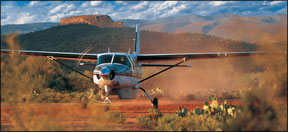
suspect a brand new student pilot could be soloed in a Caravan in about five hours, with little worry about handling the airplane safely.
Every pilot we’ve spoken to comments on how simple the airplane is to fly and how nicely it handles. While many compare it to a Cessna 182, its lighter on the controls, more solid, with even better control harmony than the Skylane.
While the 208 is easy to fly for the beginner, it does reward the more experienced pilot as finesse is developed. Its a solid instrument platform and a good pilot can use its wide speed range and high flap operating speeds to fit in at high density airports or slow nicely to get in and out of shorter strips.
Its not a STOL airplane, but it will deal with most all general aviation airports in the U.S., as we’ll as many of the unimproved strips around the world. Most versions of the series have a payload in excess of 4000 pounds; some will carry that even with a couple hours of fuel. When loaded to gross, most will climb at least 900 FPM at sea level. Given that the no-letters max takeoff weight is 8000 pounds and the B models is 8750 pounds, that’s respectable. The CG range is adequate, if not generous. Skydiving operators report that the airplane gets tail heavy with lots of jumpers hanging out and none up front, while a Twin Otter will tolerate this better.
In flight, the pilots position we’ll ahead of the wing on all models means that visibility is as good as the Skymaster. The only way to improve visibility would be to make the airframe and engine out of Plexiglas. As 208s are often found in the patterns of small town airports at any time of the day, being able to see we’ll is a nice safety feature.
For comparison, a person used to a normally aspirated Cessna 210 will feel at home with all the numbers in a 208, save for fuel flows. The speeds are comparable for climb, cruise and approach. Both use about the same amount of runway. Fully loaded, the airplanes in the 208 series take from 1200 to 1400 feet to get off the ground and about 2500 feet, worst case (Super Cargomaster) to clear a 50-foot obstacle on a standard day, at sea level.
Being able to select reverse thrust after landing is a pleasure at smaller airports or where snow removal may not be the best.
Full reverse after the mains touch puts the airplane firmly on the ground, especially if the flaps are raised immediately, so heavy braking can be laid on to stop the airplane in very short order.
No matter how long the trip, it rarely pays to climb above 8000 feet, as the fuel burned getting to altitude usually cancels any advantage gained in reduced fuel burns once there. In general, the 208s without cargo pods will move along at max cruise at about 180 knots. With a cargo pod, subtract about 10 knots from the cruise speed. Subtract 20 knots or more for floats.
All of the airplanes have 335 gallons of fuel available when full, so at max cruise power settings, figure on more than 5 hours of endurance at 10,000 feet, with reserves. Pulling the power back to max economy ups the endurance to 6.5 hours in the B models with the bigger engines and about 7 hours in the no-letter. Max operating altitude for the no-letter is 30,000 feet and 25,000 feet for the B models.
Should the engine decide that it has had enough, feathering the prop provides one of the highest glide ratios of any general aviation airplane, 13.5 to 1. At 6000 feet AGL, and 95 KIAS, the airplane will glide about 13 miles. In a circle with a diameter of 26 miles, there’s bound to be an airport or four.
One of the drawbacks to the very clean airframe and only 30 degrees of flap is frustration for some pilots with the descent rate on final, even with power off. There was some clamor in the field for 40 degrees of flaps, but the airplane cant meet the gross weight rate of climb regulations with 40 degrees of flap, so 30 degrees is the limit.
Maintenance, Mods
If Cessna set out to design a low-maintenance aircraft in the Caravan, it evidently succeeded. Frankly, we were hard-pressed to find many recurring maintenance complaints about the airplane, including some that are clearly operated in harsh environments.
Nonetheless, even the early Caravans have no significant repetitive ADs. In 1993, a new version of the PT-6A-114A developed some harmonic vibration problems but this was quickly corrected. Engine TBOs in the U.S. are 3500 hours, with hot sections at 1500 hours.
Elsewhere in the world, TBOs are higher, as much as 8000 hours. A buyer should review the engine logs for both total cycles and total hours for the hot section and the engine. If operated on salt water or in dusty areas, there should be evidence o frequent compressor washes. Most of the modifications available for Caravans reflect the airplanes role as a workhorse. Speed isn’t king, utility is. Aero Twin, Inc. (907-274-6166 and on the Web at www.aerotwin.com) will drop an 850-HP Honeywell TPE-331 and a four-blade Hartzell prop in the cowling for you. It also makes more than a dozen mods and special tools, ranging from seat packages to landing gear gravel deflectors.
Wipaire makes a line of highly regarded float products that operators say are we’ll supported in the field. Contact Wipaire 651-451-1205 and www.wipaire.com on the Web.
Flight Ice, Inc. has recently obtained an STC for known icing, TKS-based system. Contact Flight Ice at 407-895-0453 or www.flightice.com. For information on more seat mods, cargo-to-passenger conversions and combis and cargo netting for the Caravan, contact Atlantic Aero, Inc., Piedmont Triad International Airport at 800-334-2001 and www.atlanticaero.com.
Owner Feedback
If you examine Cessnas Caravan advertising, its portrayed as a go-anywhere, haul-anything, simple-to-operate machine for business and pleasure. I couldn’t agree more.
The floats on this airplane are the Cessna certification articles, and Cessna leased the aircraft when it was new to demonstrate it to floatplane operators from Florida to Canada to Alaska. The aircraft has made two trips to Russia and Mongolia (one on wheels, on floats to land on Lake Baikal), visited Greenland three times, circumnavigated the entire North American continent (north of the magnetic North Pole), and made numerous trips to the remote regions of Canada and Alaska, in addition to its business use in the U.S.
In 1999, we took the aircraft on a 50-day, 21,000 mile tour that included every country in the Caribbean, Central America, and South America, culminating in a flight to Antarctica. Even more remarkable, this trip was done on floats. In all, the airplane has been to 76 countries on six continents.
The Wipline floats are superb, our only problems were a cracked landing gear trunion on this prototype set a couple of years ago (since made stronger on production sets) and a failure of hydraulic seals from an accumulation of Antarctic mud and subsequent freezing. The aircraft is now 15 years old and we have had to replace some aging ductwork behind the panel. The only other recurring maintenance problem has been a persistent water leak when the airplane sits out in the rain, causing radio corrosion problems.
For normal operations, as a rule of thumb, set fuel flow to 300 PPH and leave the prop forward like a fixed-pitch at 1900 RPM. This yields cruise speeds of 167 to 180 knots, depending on altitude. Putting the large tires on the airplane costs about 5 knots. On floats, subtract about 22 knots.
The airplane has a very light control feel-more like a 172 than a 206 Cessna. It will operate into any field or lake that you would fly a 206 into . I tell people that you can use the same operating speeds as a 172, since most older 172s used statute MPH and the Caravan is in knots. Normal approach speeds are 75 to 80 knots; short field, use 60 knots.
The airplane flies the same whether lightly loaded or loaded to gross weight-something that cant be said for most piston-powered utility aircraft. Its certified for known icing, and handles it we’ll on wheels. When on floats, however, its not certified for icing and as little as 5/8-inch can cause it to quit climbing.
My greatest cause for concern when flying this airplane has been when flying it in potential icing conditions over the mountains or enroute to Antarctica while on floats-there’s nowhere to go if you encounter ice. There’s a lot of surface on those floats. Maybe a TKS system for the floats? We have considered the 675 HP engine upgrade. Considering that we operate the airplane to the extreme edges of its capabilities, more power would be nice. But look at all we’ve been able to do with the standard engine.
To sum up, this airplane is a real alternative to a Baron, Seneca, or Cessna 310 as a corporate aircraft. It offers similar speeds, turbine reliability, simplicity, low maintenance, huge internal capacity and short field capability. The implied promise of Cessnas advertising is true-buy one of these airplanes and go anywhere in the world.
Jim Hanson
Albert Lea, Minnesota

